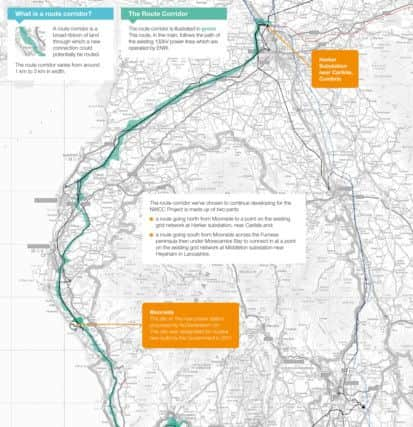National Grid chooses corridor for North West Coast Connections after extensive public consultation


The proposed tunnel is part of a National Grid connection which will link new sources of electricity including the proposed new nuclear power station at Moorside into ‘the grid’ in Cumbria and Lancashire.
The tunnel could also pave the way for a transport tunnel using the same technology, said David Morris MP.
Advertisement
Hide AdAdvertisement
Hide AdDavid Morris said: “I am really pleased that National grid have chosen the tunnel under Morecambe Bay for their upgrade of the electricity network, I have seen one of their tunnels in action in London and the technology is fascinating.


“During the design work on their tunnel routes it will also pave the way for the possibility of a transport tunnel at a later date as the technology is already there.
“The upgrade of the grid will also strengthen the case for an early build for Heysham 3 Nuclear Power station.
Work is now getting underway on the next important stage of the project which is to plan the exact line along this corridor option that the connection will take, the technologies that will be used to build it, any other necessary works and the methods that can be used to reduce its impact on the landscape.
Advertisement
Hide AdAdvertisement
Hide AdThe company has chosen the corridor after five years of discussions with key national and regional bodies and thousands of conversations with people during a consultation exercise last autumn.
Moorside will be connected at two points on the existing National Grid network to ensure security of supply.
The chosen corridor runs from Harker substation near Carlisle largely following the path of existing low voltage power lines around the Cumbrian coast to Moorside.
It then heads from Moorside to the Furness peninsula where it goes under Morecambe Bay to emerge at Middleton substation near Heysham.
Advertisement
Hide AdAdvertisement
Hide AdThere will be the opportunity for National Grid to take down some existing low voltage power lines owned by Electricity North West and to replace them with its own high voltage ones.
National Grid selected the corridor after listening to peoples’ views at a series of 33 consultation events and considering over 1,200 written responses, including 70 from local authorities and parish councils and 80 from a wide range of other bodies including the Lake District National Park, Friends of the Lake District, Natural England, English Heritage and the Environment Agency.
Robert Powell, project manager said: “We had thousands of conversations with people during autumn of last year and some key themes have emerged. People understand how important it is for us to connect new sources of generation into the grid and the task we face in doing this in a region with some of the most spectacular landscapes in the country.
“Many people think that following the path of existing power lines and taking these down to replace them with our own equipment is a good idea. There is support for our plan to cross under Morecambe Bay and this would avoid building a connection through the South Lakes.
Advertisement
Hide AdAdvertisement
Hide Ad“There are also a lot of people who would like us to put cables out of sight on the sea bed between Moorside and the Lancashire coast. We explained at the start of consultation that this wasn’t our preferred option. We’re not taking this forward for several reasons.
“NuGen, the company which is building Moorside, prefers the route we have chosen. They share our concern that offshore HVDC (high voltage direct current) cables have never been used to connect a nuclear power station. Using this untried technology could introduce risks for the Moorside project.
“The sea bed in this area is already congested with cables, gas pipes and wind turbines. Also, if an offshore cable develops a fault, it can take up to six months to repair.”
National Grid is now starting to talk to landowners and communities along the corridor it has selected about the technologies it can use to build the connection and possible locations for the equipment.
Advertisement
Hide AdAdvertisement
Hide AdThe company aims to submit an application for consent to build the new connection to the Planning Inspectorate in 2017.
A decision will then be made by the Secretary of State for the Department of Energy and Climate Change. If consent is granted, construction work is expected to start in 2019.